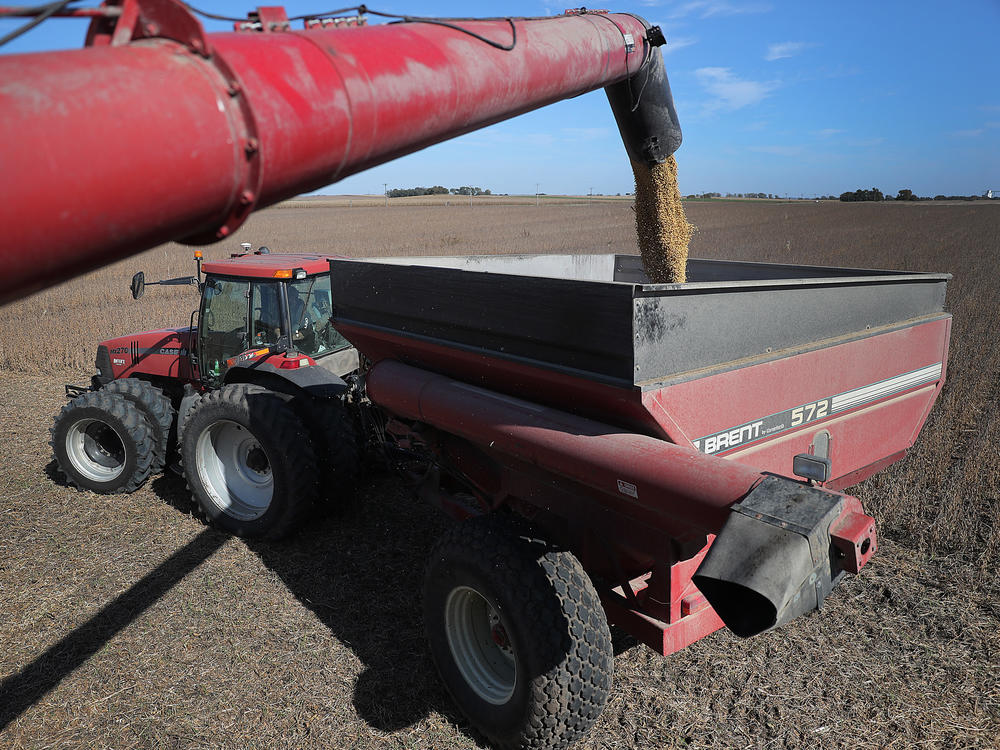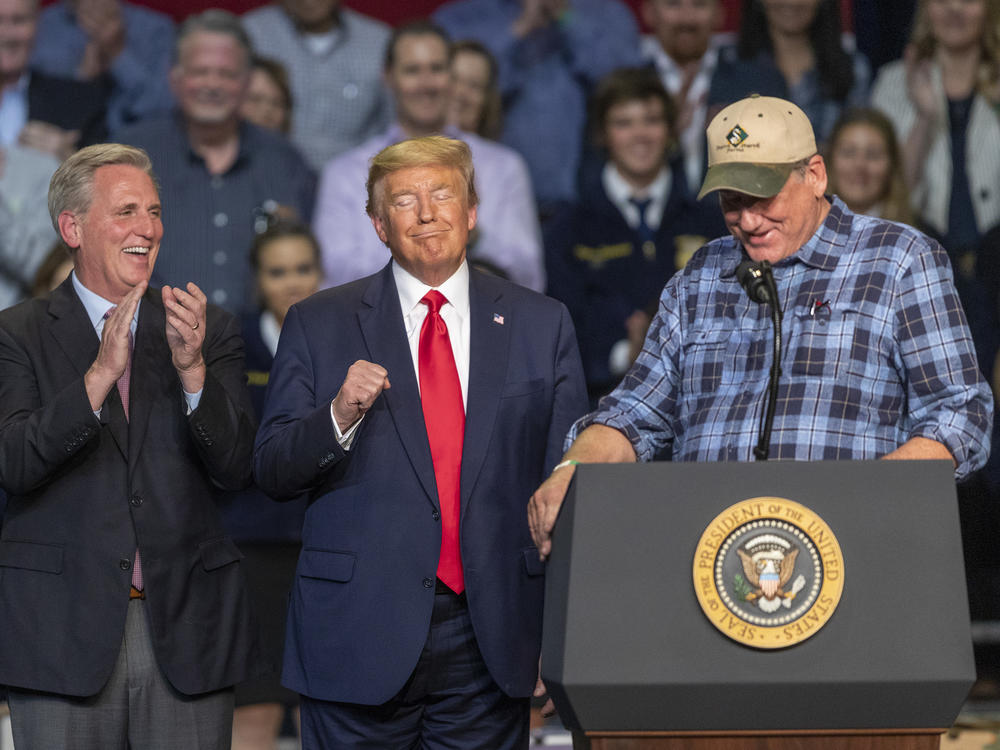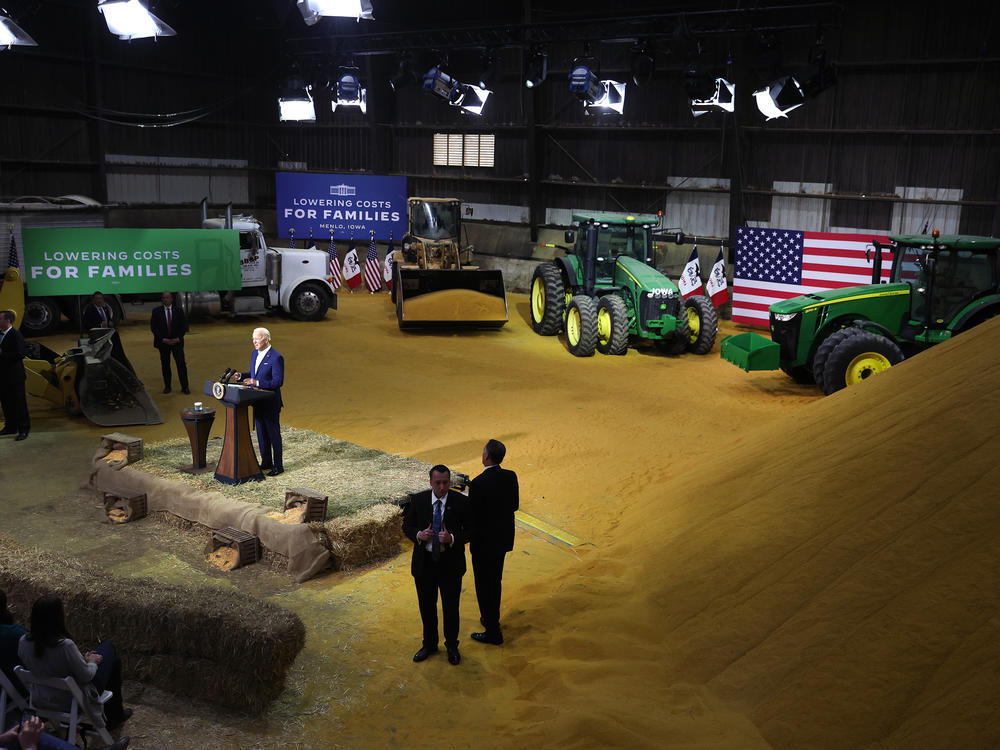Section Branding
Header Content
As farmers split from the GOP on climate change, they're getting billions to fight it
Primary Content
If you ask Iowa farmer Robb Ewoldt about the federal dollars he's received over the last few years to help make his land more sustainable, it's clear he's a big fan.
"It works out really well in our operation," says Ewoldt, who farms corn and soybeans on "just shy of 2,000 acres" near Davenport, Iowa. "We see tremendous benefits in conservation, water quality and carbon sequestration."
He's been involved with the Conservation Stewardship Program, or CSP, for about eight years now. The program aims to help farmers improve yields, increase the resilience of their fields to extreme weather and maintain and improve their conservation systems — such as no-till and cover crops.
On his farm in that time, "soil health [has] improved to a point where we see a yield advantage in our farming practices. ...We can watch those yields go up year after year. That's where the real benefit comes in," he says.
The government's conservation programs are meant to bolster farmers' response to climate change, as Ewoldt and others like him are forced to confront worsening droughts on the one hand, and unprecedented rainfall and flooding on the other. But even with billions more in federal assistance on the way, there is little sign the massive infusion of money from Democrats' recently passed Inflation Reduction Act will reshape politics in the solidly Republican state of Iowa, nor move the dial for farmers in other rural areas where the GOP maintains a seemingly irreversible foothold.
Farmers will be getting billions more for conservation
The CSP was enacted as part of the 2008 Farm Bill, but the Biden administration's Inflation Reduction Act, passed by Democrats on a straight party-line vote, has added a whopping $20 billion to it and other conservation programs specifically aimed at helping farmers combat the effects of climate change.
"This is a big chunk of funding relative to what they've had in recent years," says Cathy Day, climate policy coordinator with the National Sustainable Agriculture Coalition. She says in the past, the programs have been stretched so thin that "we generally have somewhere in the range of 3 to 4 times the farmers applying compared to those who actually get contracts."
The programs can have a huge impact for farmers and the environment, says Sara Nicholas, a policy strategist at the Pennsylvania-based nonprofit Pasa Sustainable Agriculture. She cites a 2015 study by the Natural Resources Defense Council showing that "for every additional 1% of organic matter that gets into the soil, which is what a lot of these CSP programs' practices are trying to do, those soils can capture an additional 20,000 gallons of rain per acre."
"If you think about a flood-prone state like Pennsylvania ... it would just make all the difference if you can capture that much additional rainfall before it runs off the fields, into creeks, cascading down and tearing out bridges and culverts and infrastructure," she says.
Ewoldt, who accepts climate change and says farmers "need to do things to mitigate it," acknowledges that his farming practices have "allowed my soil to hold more water during drought conditions."
The additional government funding is a good thing, he says. But Ewoldt's congressional representative, Mariannette Miller-Meeks, sided with her fellow Republicans in unanimously rejecting the Inflation Reduction Act. "Now is not the time to pass a $740 billion spending bill, let alone one filled with partisan priorities," she said in a statement.
Ewoldt plans to vote for her anyway.
"I know her," he says. "And there's other things that come into it besides the economics."
More farmers are bucking the GOP on climate
Ewoldt's attitude toward climate change reflects a growing trend among farmers. A survey published in 2021 indicates that about 80% of farmers now believe climate change is occurring. That's a huge shift from just eight years ago, when a four-state survey indicated that most did not accept the concept of climate change nor believe its impact would reduce their crop yields.
The time period over which that switch has occurred coincides with the warmest seven years on record globally, as well as climate-fueled fires, floods and heat waves in the U.S.
Even so, as a group, farmers have remained steadfast in their support of Republicans, despite the party's history of being closely associated with denying the scientific consensus on climate change. (Although among Republican voters in general, there's been a significant shift from just a decade ago).
Farmers have also been rock steady supporters of former President Donald Trump, despite a trade war with Beijing that led agricultural exports to China to plunge by more than 60%, according to the U.S. International Trade Administration. And this summer, Republicans on the House Agriculture Committee have already called for cutting commodity and conservation programs in the new Farm Bill, which will come up in Congress next year.
Ewoldt, who says he's a lifelong Republican, voted twice for Trump even though the years 2017 through 2019 were "miserable for farm production" due in large part to the then-president's trade war. Ahead of the 2020 election, he told NPR that Trump represented "the devil I know and not the devil I don't know."
Tim Dufault, 62, works 1,600 acres in northwestern Minnesota, near the town of Crookston. He's seen a lot of changes in farm fields in the state in the past several decades that he attributes to climate change.
"It's hard to refute that the world is getting warmer," he says.
The mix of crops in his corner of the state is a lot different than when he started farming four decades ago. "There's hardly any barley, sunflowers, [or] potatoes anymore because it's gotten warmer and wetter and it's harder to get a good quality crop," he says.
"In the meantime, warm season crops like soybeans and corn have moved up into this area. So, you know, that kind of really tells the story," says Dufault, who describes himself as "a moderate, but mostly Democrat."
Trade often outweighs worries about the climate
South Dakota Farm Bureau President Scott VanderWal counts himself among those who see that climate — or at least the weather — is changing, but disagree with the scientific consensus on the cause. "The climate has been changing since the Earth was created and we've been through cycles before," he says.
VanderWal says Trump's trade dispute with China hurt farmers in South Dakota, but now his frustration with President Biden is in not moving past his predecessor's policies.
In 2020, Phase 1 of a new trade agreement with China went into effect, with Beijing agreeing to purchase $80 billion worth of U.S. agricultural products in the first year.
VanderWal wonders what comes next. "We've asked them what the future [is]," he says. "It's almost two years now, and we've heard almost nothing about international trade."
Democrats face a steep challenge winning rural votes
Given rural voting patterns, which heavily favor Republicans in more rural states, shifting farmers to the blue column may seem impossible for Democrats.
It's a task made even harder by Trump's undisputed dominance of his party.
"Rural America has been mostly Republican for a couple of generations," says David Hopkins, a political science professor at Boston College. "But Trump did significantly better."
Lots of rural counties in states like Wisconsin and Pennsylvania that used to be 60-40 Republican "all of a sudden were 70-30 Republican or more" for Trump, he says.
Even so, Democrats don't need to win over a majority of farmers. Instead, "if they can cut those margins back [and] regain some of their lost ground over the last 10 years in rural areas, that might actually be important in some of those battleground states," he says.
Isaac Wright, co-founder of the Rural Voter Institute, a progressive research firm, says to get there, Democrats need a lesson in how to talk to voters outside their urban base.
"Our values are not the issue," he insists. "It's how we communicate and often how we fail to communicate."
"For one thing, I would de-emphasize using the phrase 'climate change,'" Wright says. "I would talk about how [these programs] help build our farm communities, especially our small farms, with investment for stewardship. And for clean air and clean water investments for the long term."
Timothy Hagle, an associate professor of political science at the University of Iowa, says it's also important for Democrats to realize that just hitting economic issues won't be enough.
"Yes, a farmer is going to be concerned about crop prices," he says. "But ... [farmers] also care about immigration or what's happening in the schools with my kids."
"They're not necessarily only voting on one issue, even though that one issue would seem to be pretty important, since it deals with the way they make a living."
Copyright 2022 NPR. To see more, visit https://www.npr.org.



